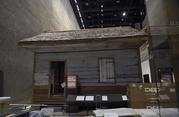- California Assembly OKs highest minimum wage in nation
- S. Korea unveils first graphic cigarette warnings
- US joins with South Korea, Japan in bid to deter North Korea
- LPGA golfer Chun In-gee finally back in action
- S. Korea won’t be top seed in final World Cup qualification round
- US men’s soccer misses 2nd straight Olympics
- US back on track in qualifying with 4-0 win over Guatemala
- High-intensity workout injuries spawn cottage industry
- CDC expands range of Zika mosquitoes into parts of Northeast
- Who knew? ‘The Walking Dead’ is helping families connect
NEW BLACK MUSEUM PREPARED TO DEAL WITH VISITORS’ EMOTIONS
WASHINGTON (AP) — America’s newest museum brings to life all the pain and tribulations of the black experience and its creators expect many visitors will be shaken by what they see and hear. 
Slave shackles sit ominously in a glass case, surrounded by whispering hymns of past pains. Nearby are artifacts from a slave ship which carried black men, women and children to lifetimes of servitude in a land not their own and a whip used to punish the backs of those whom survived the ocean voyage by cruel white masters.
In preparation, the new Smithsonian Institution National Museum of African American History and Culture has been training more than 250 docents to help visitors process their emotions. They’re being taught what to do if someone gets angry, distraught or depressed by the exhibits – to offer tissues to help dry tears, or to direct those who need to collect themselves to the museum’s Contemplative Court.
There, a circular waterfall – symbolizing the water path that many enslaved African-Americans took to freedom – cascades down the center of the room from an oculus, or circular window, which will allow sunlight to diffuse underground onto benches strategically located around the calming waters. Spread throughout the museum also are “recording booths” where visitors inspired by what they’ve seen unburden themselves and share their own stories with the Smithsonian to collect and store for future generations. In addition, it will serve as a catharsis for some.
“People get to leave behind their thoughts,” said Lonnie Bunch, the museum’s founding director.
When the museum opens on Saturday, thousands will be transported back to the time of slavery, a time of horrors few know outside of history books and sanitized images from television and movies. But technology and the museum’s environment combine to provide a more “intimate” experience, officials said, and hopefully greater understanding and reconciliation with the past.
Everything in the “Slavery and Freedom” gallery, the first place visitors are directed in the museum, is designed to attack the senses and draw out emotion: The ceilings are low, the rooms are dark and oppressive, and the walls are covered with quotes from the slavers and the enslaved, whose voices have been reproduced and are broadcast through the exhibits.
Scattered throughout the exhibit space are heart-rending exhibits like the slave manacles used on a child, the auction block from a slave auction site, and ballast blocks from a Portuguese slave ship that sank in 1794 carrying hundreds of African slaves.
“You’ll really be thinking of the people who experienced this and hear it through their own voices,” said Nancy Bercaw, curator of that gallery. Added Bunch: “This is really almost like a kind of commemorative memorial space that you can go in and pay homage to those who were lost and those who survive.”
Museums have to be prepared to deal with a variety of emotions when dealing with charged subjects like slavery and civil rights, said Priscilla Hancock Cooper, vice president of institutional programs at the Birmingham Civil Rights Institute in Alabama.
After going through the Birmingham museum, visitors are offered a chance to talk with volunteers – many of whom lived through the turbulent civil rights era in Birmingham – to help process their thoughts and feelings, Cooper said.
“There’s an opportunity for that person-to-person contact, which may be needed,” she said.
The same will likely be said for the new Smithsonian, which will tell the story of slavery in a ground-level, personal way, officials said, instead of through numbers, dates and a bird’s-eye view of the past. “One of the goals of the museum is to humanize history, to give it to you on a first-person narrative, to give it to you on a human scale,” Bunch said.
Other emotionally draining exhibits include the casket of Emmitt Till, a black Chicago teen brutally killed for whistling at a white woman in Mississippi; an authentic slave cabin from Edisto Island, South Carolina; shards of glass from the explosion of the 16th Street Baptist Church, which killed four young girls during the Civil Rights movement; a 90-year-old, 44-seat segregated Southern Railway car; and a 20-foot-plus guard tower and a cell from the Louisiana State Penitentiary prison called Angola after the slave plantation that once was on that spot.
“If we’ve done our job right, I trust the museum will be a place for all Americans to ponder, reflect, learn, rejoice, collaborate and ultimately draw sustenance and inspiration from the lessons of history,” Bunch said.












love
September 22, 2016 at 7:03 PM
News: Breaking stories & updates – News Telegraph
showbox.ooo
September 5, 2017 at 5:42 AM
gbn nbmbjjn hhvtgv v
aptoideguide.com
September 5, 2017 at 5:43 AM
nbv n n uj b b y
getitube.com
September 5, 2017 at 5:44 AM
szxsexdv h h hj g g f ftcr hj m jgvtvhvtfjn n jh b bh bb h
Jesmin
January 4, 2018 at 9:27 PM
Nice page.